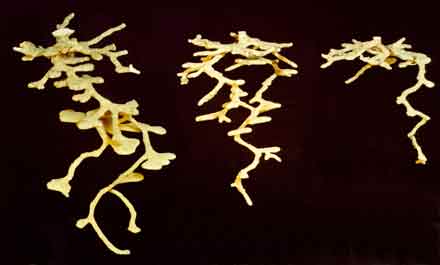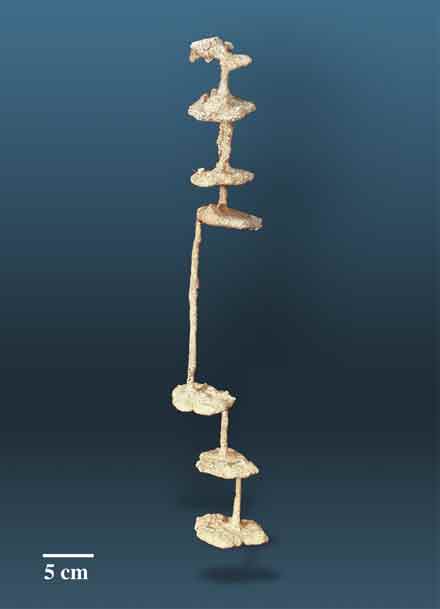ssue 4 Animals Fall 2001
Mapping Behavior
Tomas Matza
Walter Tschinkel, a Florida State University entomology professor, has been making plaster casts of ant nests since 1982, when he first heard of the strength of orthodontic plaster. The painstaking process involves pouring the plaster down the opening as quickly as it will go in. After the plaster hardens, the excavation begins, but the nest must be taken out piece by piece. (One harvester ant nest, for example, took some five gallons of plaster and came out in 180 pieces.) Sometimes more than ten feet tall, the nests are as beautiful in structure as they are complex.
 Nests dug by the Florida harvester ant under experimental conditions by 200 workers in 4 days. Photo: Charles Badland.
Nests dug by the Florida harvester ant under experimental conditions by 200 workers in 4 days. Photo: Charles Badland.Tschinkel has long been interested in nest structure, and says the first cast he made of fire ants provided him an invaluable way to visualize ant colonies as they are, that is as a three-dimensional network of tunnels and chambers. Up until that point, "seeing" nest structure was limited to compiling a series of cross-sectional cuts in the soil.
"I was astounded that the nest looked different than I had imagined," he says. "I am now convinced that nest architecture is functional because it organizes the worker force and is in turn organized by ant behavior."
As an example of this "feedback loop," Tschinkel points out that workers are arranged vertically according to age: The younger workers are born deep in the nests and spend the first part of their lives tending to the queen. As they age they move closer to the surface, eventually becoming foragers. The top of the nest, which tends to be more hollowed out with chambers, "bears the mark of the older workers partly because they have a higher tendency to dig."
"Certainly the nest is the product of their behavior," he says, "but it also serves as a ladder on which they arrange themselves. This long extended vertical structure allows them to differentiate labor so that they don't all do all the same tasks in the same chambers. It's like a factory and it's all logically arranged so that the work can move from one area to the next in an efficient manner."
 Nest dug by woodland ants. Photo: Charles Badland
Nest dug by woodland ants. Photo: Charles BadlandThe casts have also suggested new sets of questions, such as how ants know how to build highly detailed nests in the first place? Tschinkel has confirmed that different colonies of the same species of ant will typically make similar nests. This has prompted him to hypothesize that the "instructions" for nest construction are contained within every worker so that a single harvester ant, left to its own devices, might build the same structure as a group of its sisters. But he also says that it's equally likely that social interaction is needed to produce a normal nest.
Aside from their scientific value, these "inverse ant sculptures," made one grain at a time, also blend æsthetic form with function in ways that rival human architectural achievements. And Tschinkel is planning to approach major museums about exhibiting his casts. First, however, he plans to master a new method—the use of aluminum heated to over 700 degrees Celsius, which he figures will be more moveable, mountable, and require less piecing together after excavation.
The only apparent downside to making these ant sculptures is that abandoned nests tend to lose their form quickly, and therefore do not make very good casts. Instead, Tschinkel says, live nests will be sacrificed to make them, and perhaps appropriately a few ant bodies can be seen suspended in the tunnels they've made.
"Sometimes I call it the science of death. It's not something I like doing; it's just a reality. But the living world is neither timid nor cautious about death, so I'm just another agent of mortality, and not even a particularly severe one. You can't do biology without killing creatures. There are some questions you can do without killing, but ultimately you run up against the limit of what you can learn."
Tomas Matza is a writer based in San Francisco.
Cabinet is published by Immaterial Incorporated, a non-profit 501(c)(3) organization. Cabinet receives generous support from the Lambent Foundation, the Orphiflamme Foundation, the Andy Warhol Foundation for the Visual Arts, the Opaline Fund, the New York City Department of Cultural Affairs, the National Endowment for the Arts, the New York State Council on the Arts, the Danielson Foundation, the Katchadourian Family Foundation, and many individuals. All our events are free, the entire content of our many sold-out issues are on our site for free, and we offer our magazine and books at prices that are considerably below cost. Please consider supporting our work by making a tax-deductible donation by visiting here.
No comments:
Post a Comment